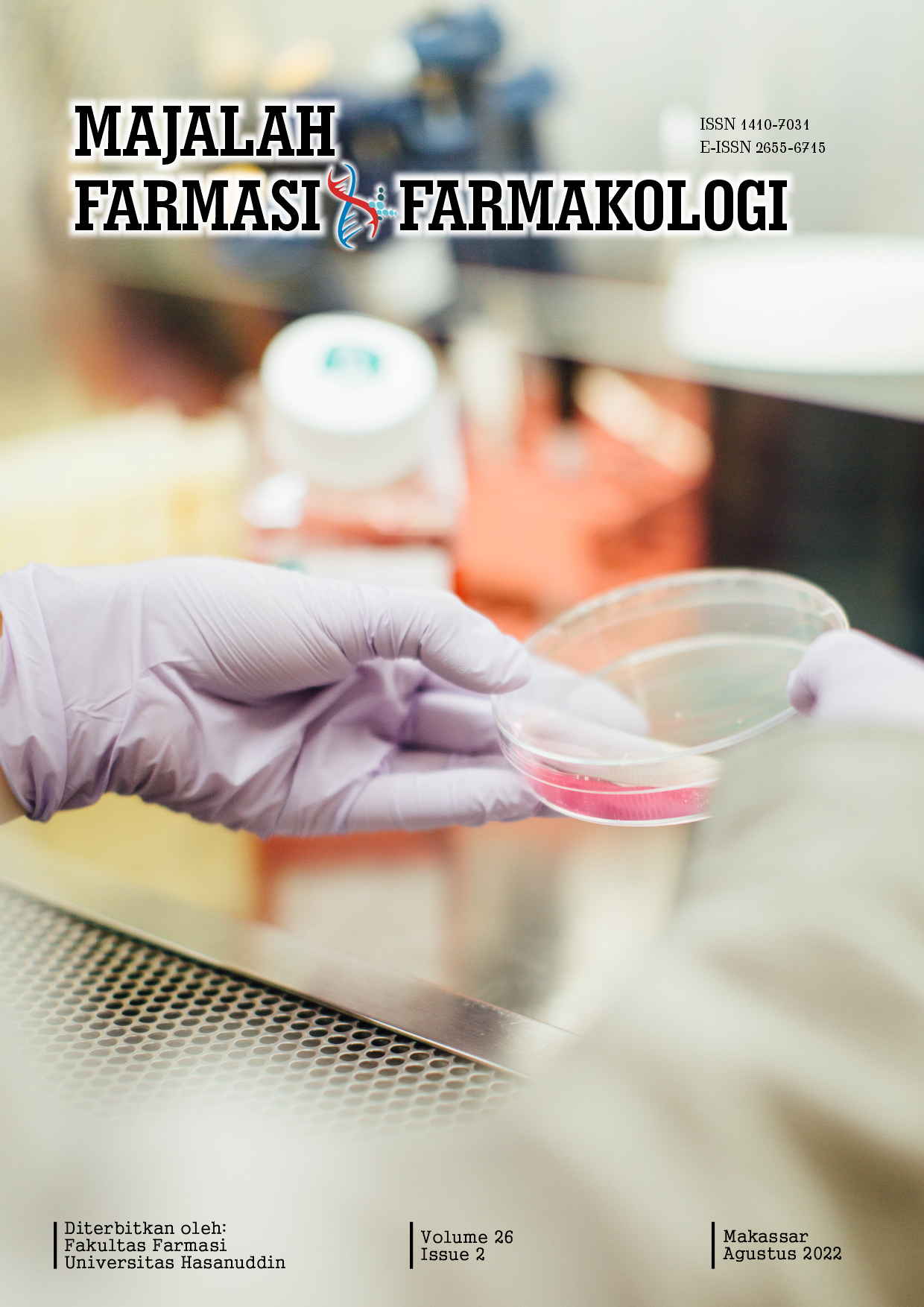KORELASI KADAR EGCG (Epigallocatechin gallate) DAN AKTIVITAS ANTIBAKTERI DARI PLASMA TIKUS (Rattus norvegicus) TERHADAP Staphylococcus aureus SETELAH PEMBERIAN FRAKSI ETANOL TEH HIJAU DOSIS TUNGGAL
Keywords:
fraksi etanol, Camellia sinensis L., epigallocatechin gallate (EGCG), Staphylococcus aureus, antibakteri., fraksi etanol, Camellia sinensis L., Epigallocatechin gallate (EGCG), Staphylococcus aureus, antibakteri.Abstract
Epigallocatechin gallate (EGCG) merupakan senyawa polifenol utama dalam teh hijau, selain epigallocatechin (EGC), epicatechin gallate (ECG) dan epicatechin (EC). Penelitian sebelumnya menunjukkan bahwa EGCG memiliki aktivitas antibakteri terhadap Staphylococcus aureus, tetapi memiliki bioavailabilitas per oral rendah. Tujuan penelitian ini untuk mengetahui korelasi kadar EGCG dalam plasma dan aktivitas antibakterinya setelah pemberian fraksi etanol teh hijau dosis tunggal 100 mg/kg bb tikus. Teh hijau diekstraksi dengan heksana 1 : 10 menggunakan metode Ultrasonic-Assisted Extraction (UAE) selama 2 x 15 menit. Fraksi tidak larut heksana diekstraksi kembali dengan metode yang sama menggunakan etanol 50 % (1:10). Fraksi etanol teh hijau yang diperoleh ditetapkan kadar total EGCG dengan metode Ultra-Fast Liquid Chromatography. Fraksi etanol teh hijau dosis 100 mg/kg bb diberikan secara per oral terhadap 3 ekor tikus jantan dan sebagai pembanding adalah diberikan larutan kolloidal CMC 1 %. Kadar EGCG dalam plasma dianalisis setelah pemberian per oral berturut-turut 15, 30, 60, dan 120 menit dan ditentukan aktivitas antibakterinya dengan metode difusi agar. Hasil penelitian menunjukkan kadar EGCG dalam plasma pada menit pengambilan ke-15, 30, 60, dan 120 berturut-turut adalah 12,674 bpj, 13,277 bpj, 13,035 bpj, dan 12,298 bpj serta memiliki aktivitas antibakteri terhadap S.aureus dengan diameter daerah hambatan rerata berturut-turut 10,93 mm, 11,39 mm, 10,81 mm, dan 9,93 mm. Hasil analisis korelasi Pearson menunjukkan nilai signifikansi kadar EGCG dan aktivitas antibakteri plasma setelah pemberian fraksi etanol teh hijau pada menit ke-15, 30, 60, dan 120 yaitu 0,037 (p<0,05). Kesimpulan: ada korelasi antara kadar EGCG fraksi etanol teh hijau dalam plasma dengan aktivitas antibakterinya.
References
Algammal AM, Hetta AF, Elkelish A, et al. Methicillin-Resistant Staphylococcus aureus (MRSA): One health perspective approach to the bacterium epidemiology, virulence factors, antibiotic-resistance, and zoonotic impact. Infection and Drug Resistance, 2020, 13: 3255.
Chandra H, Bishnoi P, Yadav A, Patni B, Mishra AP, Nautiyal AR. Antimicrobial Resistance and the Alternative Resources with Special Emphasis on Plant-Based Antimicrobials—A Review. Plants. 2017; 6(2):16. https://doi.org/10.3390/plants6020016
Zhang H., Tang B. and Row K. Extraction of catechin compounds from green tea with a new green solvent. Chem. Res. Chin. Univ. 2014. 30, 37–41. https://doi.org/10.1007/s40242-014-3339-0
Perva-Uzunalić A, Škerget M, Knez Ž, Weinreich B, Otto F, Grüner S. Extraction of Active Ingredients from Green Tea (Camellia sinensis): Extraction Efficiency of Major Catechins and Caffeine. Food Chemistry. 2006;96(4):597-605. DOI:10.1016/j.foodchem.2005.03.015
Sartini S, Djide MN, Amir MN, Permana AD. Phenolic-Rich Green Tea Extract Increases the Antibacterial Activity of Amoxicillin Against Staphylococcus aureus by in Vitro and Ex Vivo Studies. Journal of Pharmacy & Pharmacognosy Research. 2020;8(6):491-500.
Zhao Y, Qu Y, Tang J, Chen J, Liu J. Tea Catechin Inhibits Biofilm Formation of Methicillin-Resistant S. aureus. Journal of Food Quality. 2021. https://doi.org/10.1155/2021/8873091
Melok AL, Lee LH, Yussof SAM, Chu T. Green Tea Polyphenol epigallocatechin-3-gallate-stearate Inhibits the Growth of Streptococcus mutans: a Promising New Approach in Caries Prevention. Dentistry Journal. 2018;6(3):38. DOI:10.3390/dj6030038
Arjuna A, Pratama WS, Sartini, Mufidah. An Initial Study on Anti-Biofilm Activity of Green Tea and Black Tea Extracts on Streptococcus mutans Via Microtiter Plate Assay. Jurnal Farmasi Galenika (Galenika Journal of Pharmacy) (e-Journal). 2018;4(1):44-49. https://doi.org/10.22487/j24428744.2018.v4.i1.9965
Reygaert W, Jusufi I. Green Tea as an Effective Antimicrobial for Urinary Tract Infections Caused by Escherichia coli. Frontiers in Microbiology. 2013;4(6):1-4. DOI:10.3389/fmicb.2013.00162
Kitichalermkiat A, Katsuki M, Sato J, Sonoda T, Masuda Y, Honjoh K-ichi, Miyamoto T. Effect of Epigallocatechin gallate on Gene Expression of Staphylococcus aureus. Journal of Global Antimicrobial Resistance. 2020;22:854-859. DOI:10.1016/j.jgar.2020.06.006
Xing L, Zhang H, Qi R, Tsao R, Mine Y. Recent Advances in the Understanding of the Health Benefits and Molecular Mechanisms Associated with Green Tea Polyphenols. Journal of Agricultural and Food Chemistry. 2019;67(4):1029-1043. DOI:10.1021/acs.jafc.8b06146
Hiep NT, Duong HT, Anh DT, Nguyen NH, Thai DQ, Linh DTT, Anh VTH, Khoi NM. Subcritical Water Extraction of Epigallocatechin gallate from Camellia sinensis and Optimization Study Using Response Surface Methodology. Processes. 2020;8(9):1028. DOI:10.3390/pr8091028
Luo Q, Zhang J-R, Li H-B, Wu D-T, Geng F, Corke H, Wei X-L, Gan R-Y. Green Extraction of Antioxidant Polyphenols from Green Tea (Camellia sinensis). Antioxidants. 2020;9(9):785. DOI:10.3390/antiox9090785
-Y, Li X-M, Liang J-P, Xiang L-P, Wang K-R., Shi Y-L, Yang R, Shi M, Ye J-H, Lu J-L, Zheng X-Q, Liang Y-R. Bioavailability of Tea Catechins and Its Improvement. Molecules. 2018;23(9):10-13. DOI:10.3390/molecules23092346.
Wang L, Huang X, Jing H, Ma C, Wang H. Blossomes as Effective Delivery Systems to Improve the Gastrointestinal Stability and Bioavailability of Epigallocatechin gallate (EGCG). Food Research International. 2021;149. https://doi.org/10.1016/j.foodres.2021.110631
Vilkhu K, Mawson R, Simons L, Bates D. Applications and Opportunities for Ultrasound Assisted Extraction in the Food Industry: a Review. Innovative Food Science & Emerging Technologies. 2008;9(2):161-169. DOI:10.1016/j.ifset.2007.04.014
Koch W, Kukuła-Koch W, Czop M, Helon P, Gumbarewicz E. The Role of Extracting Solvents in the Recovery of Polyphenols from Green Tea and Its Antiradical Activity Supported by Principal Component Analysis. Molecules. 2020;25(9):1-14. DOI:10.3390/molecules25092173
Takagaki A, Nanjo F. Metabolism of (-)-Epigallocatechin gallate by Rat Intestinal Flora. Journal of Agricultural and Food Chemistry. 2010;58(2):1313-1321. DOI:10.1021/jf903375s
Liu Z, Bruins ME, Ni L, Vincken JP. Green and Black Tea Phenolics: Bioavailability, Transformation by Colonic Microbiota, and Modulation of Colonic Microbiota. Journal of Agricultural and Food Chemistry. 2018;66(32):8469-8477. DOI:10.1021/acs.jafc.8b02233
Janle EM, Morré DM, Morré DJ, Zhou Q, Zhu Y. Pharmacokinetics of Green Tea Catechins in Extract and Sustained-Release Preparations. Journal of Dietary Supplements. 2008;5(3):248-263. DOI:10.1080/19390210802414279
Renzetti A, Betts JW, Fukumoto K, Rutherford RN. Antibacterial Green Tea Catechins from a Molecular Perspective: Mechanisms of Action and Structure-Activity Relationships. Food & Function. 2020;11(11):9370-
Downloads
Published
Issue
Section
License
Copyright (c) 2022 Majalah Farmasi dan Farmakologi

This work is licensed under a Creative Commons Attribution-NonCommercial 4.0 International License.
The copyright to this article is transferred to Universitas Hasanuddin (UNHAS) if and when the article is accepted for publication. The undersigned hereby transfers all rights in and to the paper including without limitation all copyrights to UNHAS. The undersigned hereby represents and warrants that the paper is original and that he/she is the author of the paper, except for material that is clearly identified as to its original source, with permission notices from the copyright owners where required. The undersigned represents that he/she has the power and authority to make and execute this assignment.
We declare that:
- This paper has not been published in the same form elsewhere.
- It will not be submitted anywhere else for publication prior to acceptance/rejection by this Journal.
- A copyright permission is obtained for materials published elsewhere and which require this permission for reproduction.
Furthermore, I/We hereby transfer the unlimited rights of publication of the above-mentioned paper in whole to UNHAS The copyright transfer covers the exclusive right to reproduce and distribute the article, including reprints, translations, photographic reproductions, microform, electronic form (offline, online) or any other reproductions of similar nature.
The corresponding author signs for and accepts responsibility for releasing this material on behalf of any and all co-authors. This agreement is to be signed by at least one of the authors who have obtained the assent of the co-author(s) where applicable. After submission of this agreement signed by the corresponding author, changes of authorship or in the order of the authors listed will not be accepted.


